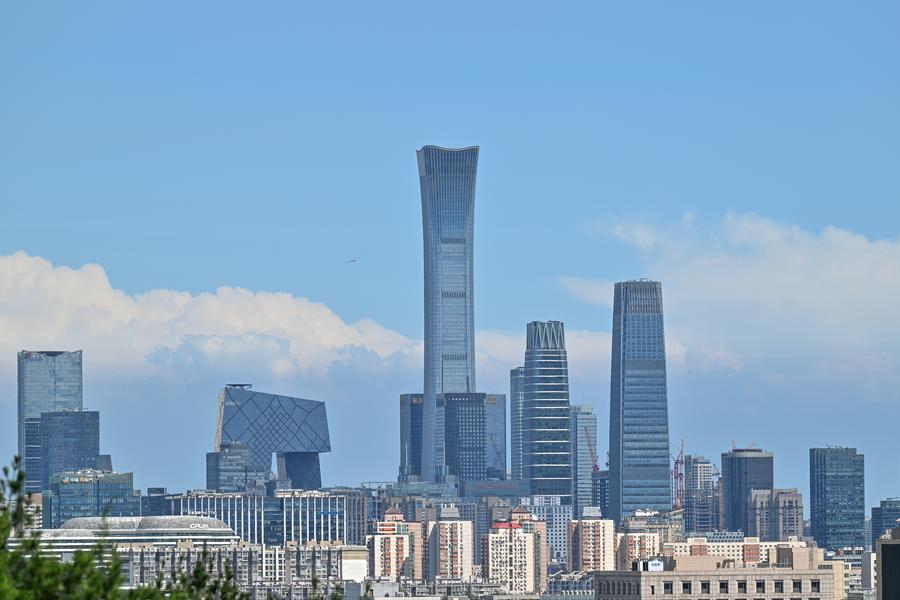Key economic takeaways from two sessions - 2025-03-30

This photo taken from Jingshan Hill on Aug 12, 2024 shows the skyscrapers of the central business district (CBD) on a sunny day in Beijing.
In the first week of this month, China held its annual two sessions, namely the meetings of the National People's Congress and the National Committee of the Chinese People's Political Consultative Conference. This is when the country draws up plans for its economic and social development for the whole year.
Among all the development goals and key tasks in this year's Government Work Report, what drew the most attention was the GDP growth target of around five percent. In 2024, China set the same goal and achieved it despite external pressures and internal difficulties. So, why is five percent still relevant for 2025?
To begin with, by setting this target, China is sending out a positive message that it is determined to keep its economic growth steady, which is fundamental to building market confidence. To reach the target, the government will maintain stable and consistent policies, providing a much-needed predictable environment for investors.
When confident, enterprises are more likely to invest in expansion, innovation, and workforce, boosting the labor market. Economists estimate that a one percent rise in GDP can create 2 million new jobs. So, a five percent growth will play a significant role in stabilizing employment. China's digital economy, for instance, has expanded by 6 trillion yuan last year and is projected to provide jobs for 323 million people in 2025.
More importantly, setting the growth target at five percent is vital for stimulating consumption. When businesses make higher profits, they usually raise wages to attract and keep talent. This directly translates to income growth for the people, making them more willing to spend. In 2024, China's new energy vehicle market saw a record sale of 12.86 million units, which shows the strong consumption power driven by economic growth.
That said, inadequate domestic demand, particularly insufficient consumption, remains a weak link in China's economy. To address this, the report has laid out plans to "vigorously boost consumption." This includes issuing 300 billion yuan worth of ultra-long special treasury bonds to support the consumer goods trade-in programs. Launched last year as a key measure to promote consumer spending, these programs will continue to offer incentives for the purchase of vehicles, home appliances, digital devices, etc.
This year, buyers of energy-efficient home appliances can receive subsidies of 15 to 20 percent of the product price. For new mobile phones, tablets and smart watches priced under 6,000 yuan, 15 percent subsidies are also available, with a maximum 500 yuan per item. According to the Ministry of Commerce, within just 20 days after these policies were announced, over 20 million citizens applied for subsidies for more than 25 million devices.
There is also much more potential to be unleashed in the service sector. During this year's Spring Festival holiday, China's film industry set a new record with a total box office revenue of 9.51 billion yuan. The animated film Ne Zha 2 emerged as the biggest hit and made a sensation across the world. By March 15, it had already climbed into the top five of the world's highest grossing movies.
The 2025 Asian Winter Games, held last February, has spurred more spending on ice and snow activities. Statistics show that during the 2024-2025 snow season, snow-related tourism generated an estimated 630 billion yuan. Harbin, the host city of the Games, attracted over 90 million travelers who spent a total of 137 billion yuan.
On macro policies, China will adopt a more proactive fiscal policy in 2025. The deficit-to-GDP ratio will be raised to four percent, and the government deficit is set at 5.66 trillion yuan, an increase of 1.6 trillion yuan from last year. The total amount of ultra-long special treasury bonds will be expanded to 1.3 trillion yuan, most of which will be utilized to support major national strategic priorities, such as public service, high-standard farmland, urban renewal, economic belt, and major infrastructure projects, such as railways, airports, and harbors.
For the first time in more than a decade, China has shifted its macro policy orientation to an appropriately accommodative monetary policy from a prudent one. By making timely cuts to interest rates and reserve requirement ratios and increasing money supply, the policy will lower the costs for lending and inject more liquidity into the market, making it easier for both enterprises and citizens to access funding.
An appropriately accommodative monetary policy will also promote industrial upgrading and high-quality development. By using monetary policy instruments effectively, more funds will be directed to strategic emerging industries, such as commercial space, the low-altitude economy, and deep-sea science and technology.
To conclude, the new growth target for 2025 demonstrates a strong sense of confidence, and speaks volumes about the potential and resilience of China's economy. With these comprehensive policy measures in place, China will navigate through the challenging waters and continue to serve as one of the key locomotives of the global economy.
The author is Yi Xin, a Beijing-based international affairs commentator.
Source: China Daily
Application Status
| 04-16 | 21315227 | Processing |
| 03-12 | 21315226 | Processing |
| 09-26 | 21315225 | Processing |
Inquiry Status
| 02-29 | 02131558 | Received |
| 03-06 | 02131557 | Received |
| 11-14 | 02131556 | Received |
FAQ
Q: Q: Is there a place where I can get...
A: A: Log on to http://touch.shio.gov....
A: A: Log on to http://touch.shio.gov....
Q: Q: What is the easiest way to set u...
A: A: 1. Log on to http://touch.shio.g...
A: A: 1. Log on to http://touch.shio.g...
Q: Where can I get an English map of S...
A: English maps of Shanghai are availa...
A: English maps of Shanghai are availa...

